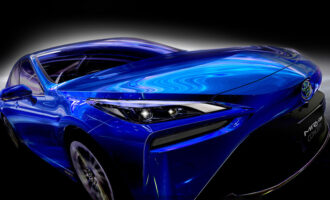
Combustion vs electrification: Are super lean-burn engines the key to emissions reduction?
Some OEMs have delayed a headlong leap into plug-in technology until the infrastructure is more certain, instead focusing on improving efficiencies of internal combustion technology. Others are focused entirely on the presentation of battery electric vehicles (BEV). Navigating regulation, market demands, cost advantages and risks is a difficult balancing act for automakers.
In 2018, the global electric car volume exceeded five million, a two million unit increase from 2017. However, the global fleet of 1.3 billion vehicles continues to be dominated by the internal combustion engine (ICE). Though, the fleet mix is changing, and at an increasing speed, as automakers try to keep up with tightening regulations that measure tailpipe emissions.
Life isn’t over for the ICE just yet. Timothy Johnson, executive consultant for Corning Environmental Technologies, speaking at the 2019 JSAE/SAE Powertrains, Fuels and Lubricants International Meeting on 29 August 2019 in Kyoto, Japan, suggests ICE-based technologies can achieve reductions in carbon dioxide (CO2) of approximately 50% from today’s levels. However, as CO2 regulations keep tightening, the fleet mix will need to shift even faster. Battery electric vehicles (BEV) are the future, he says. The uncertainty is the timing.
Projections on the speed of this transition are many and varied, ranging from less than 20% to greater than 60% by 2030 in published forecasts. “In general, it takes about 20 years for automotive technology to penetrate 80% market share after first market introduction. Fuel consumption technologies are generally more stubborn,” says Johnson. BEV and plug-in hybrid electric vehicle (PHEV) growth in China and the United States was approximately 80% in 2018. China makes up approximately 55% of the global electric vehicle (EV) market.
Investments in internal combustion engine technology will become increasingly difficult as batteries improve and costs continue to fall — and battery costs are falling faster than many projections. Lithium and cobalt, thought to be challenged on the raw material supply side, are now projected to have surplus supply through 2023-2025; although there is the possibility of a nickel shortage through 2030. In terms of costs, Tesla has forecast battery costs of USD80/kWh in 2022. With OEM cost parity between mid-range BEVs and conventional powertrains by 2025, the stage is set for a ramp-up of BEVs.
However, an immediate shift to BEVs may not be the best thing for reducing CO2 emissions.
LowCVP, a public-private partnership in the United Kingdom focused on the sustainable shift to lower carbon, cleaner vehicles, has called for the introduction of lifecycle assessment of CO2 emissions to better inform policy and technology choices. While most CO2 emissions occur during vehicle operation, LowCVP believes over 70% of emissions from new on-road vehicles could occur during the production phase of the lifecycle by 2030.
Lifecycle assessment refers to the total emissions from all stages in a vehicle’s life — including vehicle manufacturing, transportation to the point of sale location, operation, and disposal. Considerations such as the percentage of recycled material used in manufacture and future recyclability of components also form part of the assessment. The approach contrasts current legislation where tailpipe measurements are taken during certification tests to demonstrate compliance.
However, critics of lifecycle analysis suggest objective, numerical values are not available at an individual model level and the approach is highly complex with high costs and a great deal of uncertainty.

Yuichiro Fujiyama of JXTG Nippon Oil & Energy Corporation suggests if vehicles with super lean-burn engines can be brought to market in 2030, and combined with next-generation fuels, they will outperform BEVs in terms of lifecycle CO2 emissions. Speaking at the JSAE/SAE conference on “Challenges in energy supplier under Japanese diversified market toward 2050,” Fujiyama suggested operating engines with a higher air/fuel ratio, allowing combustion to take place at lower temperatures. As a result, less heat energy is lost resulting in higher thermal efficiency.
The JXTG Nippon Oil & Energy representative highlighted lifecycle emissions for hybrid electric vehicles (HEV) with a super lean-burn (plus next-generation fuel) of approximately 10 tCO2 lower than the equivalent emissions for BEVs. Fujiyama’s calculations included the assumptions that gasoline-powered vehicles will improve by 3.45% per year, a 50% higher thermal efficiency will be achieved with super lean-burn engines (compared to 2017), lighter vehicles, and considerations around autonomous vehicles, car-sharing and recycling of materials.
In addition to efforts on super lean-burn engines, the Tokyo-based corporation says it is working on several greener energy projects including an integrated process for producing ethanol from cellulosic biomass. The manufacturing process, simultaneous saccharification and fermentation (SSF), converts biomass efficiently into ethanol. The company is also working on the conversion of CO2 into liquid fuels using renewable energies such as CO2-free hydrogen and e-fuels.
Founded in 1888 as Nippon Oil Co., JXTG Holdings has net sales of JPY10.7 trillion (USD99 billion), an operating income of JPY490 billion (USD4.5 billion), and is the leading supplier of liquid fuels in Japan with 50% market share (2017). While BEVs and FCEVs are growing in popularity in the region, the company estimates more than half of new vehicles sold in 2050 will still have an ICE. Is boosting the thermal efficiency of these engines, with a focus on lifecycle emissions, the key to reducing CO2 emitted by Japanese automobiles?
While several studies have confirmed that most of the energy consumed is during the operational phase of a vehicle’s lifecycle, how the energy is produced is also an important consideration. For a zero-emissions outcome during recharging, a commitment to 100% renewable energy is necessary. When connecting to a grid that has elected against renewable energy, emissions will depend on the location of the power source.
A 2017 “Comparative study on lifecycle CO2 emissions from the production of electric and conventional vehicles in China” reinforces the view that determining an EVs potential to reduce emissions based on the use phase is not complete enough. The study analyses EVs in China, the world’s largest EV market, using a lifecycle framework in which consumption of all processes is assessed. The CO2 emissions from the production of EVs were calculated at 14.6-14.7 tonnes, a staggering 59% higher than the level of an ICE vehicle. The CO2 emissions from the production of EVs were calculated at 14.6-14.7 tonnes, a staggering 59% higher than the level of an ICE vehicle. The authors suggest that advanced battery production techniques and developed materials recycle industries are the reasons for major differences between the U.S. and China. The lifecycle emissions in the U.S. are still higher for EV, however.
The research attributes the higher emissions to the manufacturing of a heavier body and chassis, special components in EVs which include the traction motor and electronic controller, and the production of batteries and attachments. The production of lithium-ion (Li-ion) batteries for EV creates 3.8/4.0 times more CO2 emissions. In addition, more CO2 is produced during assembly.
Despite China being a frontrunner in EV production, the research submits that the region is still at a primary stage in manufacturing technologies, with significant opportunity for improvement. By way of example, a Li-ion battery produced in the United States emits around 1.1 t-CO2 emissions, one-third of the level of emissions as in China.







